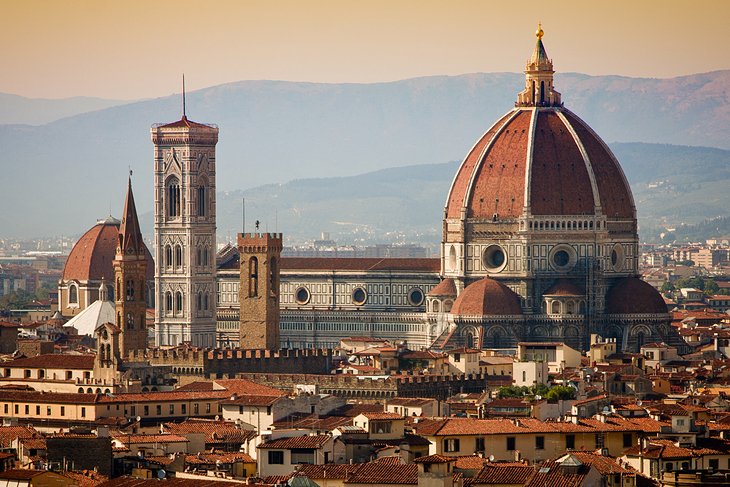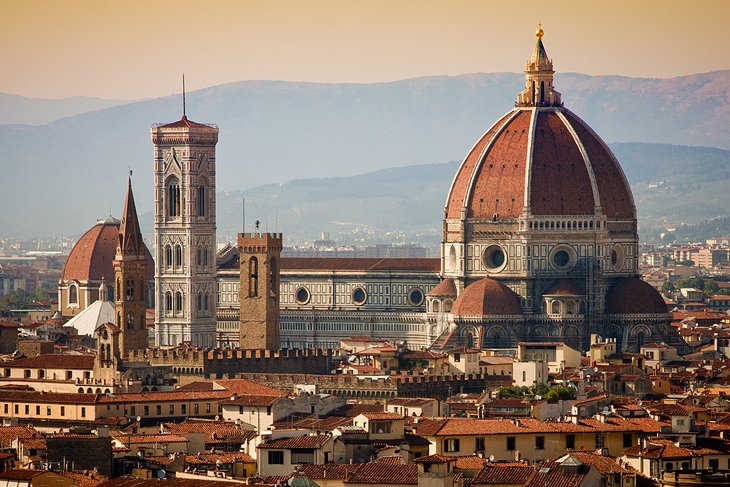
Florence, the capital of Italy’s Tuscany region, is a city that whispers tales of the Renaissance, a living testament to human ingenuity, artistic brilliance, and profound historical moments. Nestled on the Arno River, this compact yet incredibly rich city draws millions of visitors annually, eager to immerse themselves in its unparalleled artistic heritage, architectural marvels, and vibrant atmosphere. From soaring cathedrals to captivating art galleries, Florence offers an experience that transcends mere sightseeing, leaving an indelible mark on every soul.
A Tapestry of Time: Florence’s Rich History
Florence’s story is intrinsically linked to the artistic and intellectual explosion of the Renaissance, a period that began in the 14th century and transformed the course of Western civilization. The city’s prosperity, fueled by banking and trade, provided a fertile ground for wealthy patrons like the Medici family to commission masterpieces and foster artistic genius.

Related Articles about Florence: A Renaissance Jewel Brimming with Art, History, and Unforgettable Experiences:
- Austria: A Symphony of Scenery, History, and Culture
- Austria: A Symphony of Scenery, History, and Culture
- Hungary: A Tapestry of Timeless Charm, Thermal Wonders, and Vibrant Culture
- Beyond the Glitz: A Comprehensive Guide to the Best Hotels and Experiences in Las Vegas
- Sweden’s Enchanting Embrace: A Guide to its Finest Hotels and Unforgettable Experiences
The Medici family, a powerful dynasty that dominated Florentine politics and culture for centuries, played a pivotal role in shaping the city’s destiny. Their patronage supported artists like Leonardo da Vinci, Michelangelo, and Botticelli, whose works now form the cornerstone of Florence’s artistic legacy.
Beyond its Renaissance glory, Florence boasts a history stretching back to Roman times. It was a vital Roman settlement, and its medieval past is evident in its well-preserved streets and fortifications. The city experienced periods of republic, rule by various powerful families, and eventually became part of the Grand Duchy of Tuscany. In the 19th century, Florence briefly served as the capital of a unified Italy before Rome took over. This layered history is palpable in every piazza, every church, and every cobblestone street.
Unveiling the Treasures: Florence’s Top Attractions
Florence is an embarrassment of riches when it comes to attractions. Planning your visit to maximize your experience is key. Here are some of the absolute must-sees:
1. The Duomo Complex (Cattedrale di Santa Maria del Fiore, Giotto’s Campanile, and the Baptistery of St. John): This iconic ensemble dominates the Florentine skyline and is the undisputed heart of the city.
- Cattedrale di Santa Maria del Fiore (Florence Cathedral): The sheer scale and beauty of Brunelleschi’s dome are breathtaking. Ascend to the top for panoramic views of Florence – a truly unforgettable experience. The intricate facade, adorned with pink, green, and white marble, is a masterpiece of Gothic architecture.
- Giotto’s Campanile (Giotto’s Bell Tower): Adjacent to the Duomo, this elegant bell tower offers another spectacular vantage point. Climbing its 414 steps reveals stunning architectural details and a different perspective of the city.
- Battistero di San Giovanni (Baptistery of St. John): Famous for its magnificent bronze doors, particularly Ghiberti’s "Gates of Paradise," this octagonal building is a testament to Florentine craftsmanship.

2. The Uffizi Gallery: Prepare to be overwhelmed by one of the world’s most important art museums. Home to an unparalleled collection of Renaissance masterpieces, the Uffizi houses works by Botticelli ("The Birth of Venus," "Primavera"), Leonardo da Vinci ("Annunciation"), Michelangelo, Raphael, and many others. Booking tickets in advance is absolutely essential to avoid long queues.
3. Accademia Gallery: While the Uffizi boasts a vast collection, the Accademia is primarily famous for one thing: Michelangelo’s David. Standing before this colossal marble sculpture is a profoundly moving experience. The gallery also houses other works by Michelangelo and a collection of Florentine paintings.
4. Ponte Vecchio: This medieval bridge, uniquely lined with shops built along its sides, is Florence’s oldest bridge and a symbol of the city. Originally home to butchers, it was later taken over by jewelers, a tradition that continues today. It offers charming views of the Arno River, especially at sunset.
5. Palazzo Pitti and Boboli Gardens: Across the Arno, Palazzo Pitti is a vast Renaissance palace that once served as the residence of the Medici grand dukes. It now houses several museums, including the Palatine Gallery with its impressive collection of Raphael and Titian. The adjoining Boboli Gardens are a stunning example of Italian garden design, featuring fountains, sculptures, and grottoes, offering a tranquil escape from the city’s bustle.
6. Piazza della Signoria: This grand public square is the political heart of Florence, dominated by the imposing Palazzo Vecchio (Old Palace), the city’s town hall. The piazza is an open-air sculpture gallery, featuring a replica of Michelangelo’s David and Cellini’s Perseus with the Head of Medusa.
7. Santa Croce Church: Known as the "Temple of Italian Glories," Santa Croce is the burial place of many illustrious Italians, including Michelangelo, Galileo Galilei, and Machiavelli. Its stunning frescoes and impressive architecture make it a significant historical and artistic site.
8. Mercato Centrale (Central Market): For a taste of authentic Florentine life and cuisine, head to the Central Market. The ground floor bustles with vendors selling fresh produce, meats, cheeses, and local specialties, while the upstairs food court offers a delicious array of prepared dishes and artisanal products. It’s a perfect spot for lunch or a culinary exploration.
Navigating Florence: Essential Travel Tips
Florence is a walkable city, but smart planning can enhance your experience:
- Book in Advance: For major attractions like the Uffizi Gallery, Accademia Gallery, and the Duomo climb, booking tickets online well in advance is crucial to avoid hours of waiting.
- Wear Comfortable Shoes: You’ll be doing a lot of walking on cobblestone streets, so comfortable footwear is a must.
- Hydration is Key: Especially during warmer months, carry a reusable water bottle. There are many public fountains with potable water throughout the city.
- Learn Basic Italian Phrases: While English is widely spoken in tourist areas, knowing a few basic Italian phrases like "Buongiorno" (Good morning), "Grazie" (Thank you), and "Prego" (You’re welcome) will be greatly appreciated.
- Pace Yourself: Florence is rich in art and history. Don’t try to see everything in a day. Allow yourself time to soak in the atmosphere and enjoy the smaller details.
- Beware of Pickpockets: Like any popular tourist destination, be mindful of your belongings, especially in crowded areas.
- Enjoy the "Dolce Vita": Take time to sit at a cafe, savor a gelato, and people-watch. The Florentine way of life is as much an attraction as its monuments.
Finding Your Florentine Haven: Accommodation Options
Florence offers a wide range of accommodation to suit every budget and preference:
- Luxury Hotels: For an opulent experience, consider hotels in the Oltrarno district or near the Duomo, offering stunning views and impeccable service.
- Boutique Hotels: Many charming boutique hotels are tucked away in historic buildings, offering a more intimate and personalized stay.
- Mid-Range Hotels: Numerous comfortable and well-located hotels can be found throughout the city, providing excellent value for money.
- Apartment Rentals: For longer stays or for families, renting an apartment can be a cost-effective and convenient option, allowing you to experience local living.
- Hostels: Florence has a good selection of hostels, ideal for budget travelers and those looking to socialize.
Neighborhoods to Consider:
- Duomo Area: Central and convenient for most attractions, but can be the most crowded and expensive.
- Oltrarno: Across the Arno, known for its artisan workshops, charming streets, and more authentic feel.
- Santa Croce Area: Lively and full of restaurants and bars, offering a good balance of accessibility and local atmosphere.
- San Lorenzo: Home to the Central Market, this area offers a more down-to-earth experience.
Effortless Exploration: Transportation in Florence
Florence is a wonderfully pedestrian-friendly city. However, for longer distances or when arriving from afar, consider these transportation options:
- Walking: This is the best way to explore the historic center. Most major attractions are within walking distance of each other.
- Buses: Florence has an efficient bus system that can take you to areas slightly further out or if your feet need a rest. Tickets can be purchased at tobacco shops (tabaccherie) or newsstands.
- Trams: The tram system connects the city center with the airport and outskirts, offering a convenient option for arrival and departure.
- Taxis: Taxis are readily available, but can be expensive. They are metered, so ensure the meter is running.
- Bicycle Rentals: Florence is becoming more bike-friendly, and renting a bicycle can be a fun way to explore the city, especially along the Arno River.
- Florence Airport (FLR): Peretola Airport is located a short distance from the city center. Trams, buses, and taxis are available for transfer.
- Florence SMN Station: Santa Maria Novella is the main train station, a hub for national and international rail travel. It’s located within walking distance of the historic center.
Embracing the Tuscan Sun: Best Time to Visit Florence
Florence experiences distinct seasons, each offering a unique charm:
- Spring (April – May): This is arguably the best time to visit. The weather is pleasant, the city is in bloom, and the crowds are generally smaller than in peak summer. Expect mild temperatures and a vibrant atmosphere.
- Autumn (September – October): Similar to spring, autumn offers agreeable weather and fewer crowds. The colors of the Tuscan countryside are breathtaking, and the harvest season brings delicious local produce.
- Summer (June – August): This is the peak tourist season. Expect hot temperatures, long daylight hours, and larger crowds. While vibrant, it can be challenging to navigate the heat and queues.
- Winter (November – March): Florence in winter offers a more subdued and intimate experience. The crowds are significantly smaller, and you can enjoy the museums and attractions at a more relaxed pace. Prices for accommodation may also be lower. However, the weather can be chilly and damp.
Shoulder seasons (late spring and early autumn) are highly recommended for a balanced experience of good weather, manageable crowds, and a lively atmosphere.
Florence is more than just a destination; it’s an immersion into a world of unparalleled beauty and profound human achievement. From the artistic genius of the Renaissance to the simple pleasure of a sunset over the Arno, this Tuscan jewel promises an unforgettable journey that will linger in your memory long after you’ve departed. Prepare to be captivated, inspired, and utterly enchanted by the magic of Florence.





